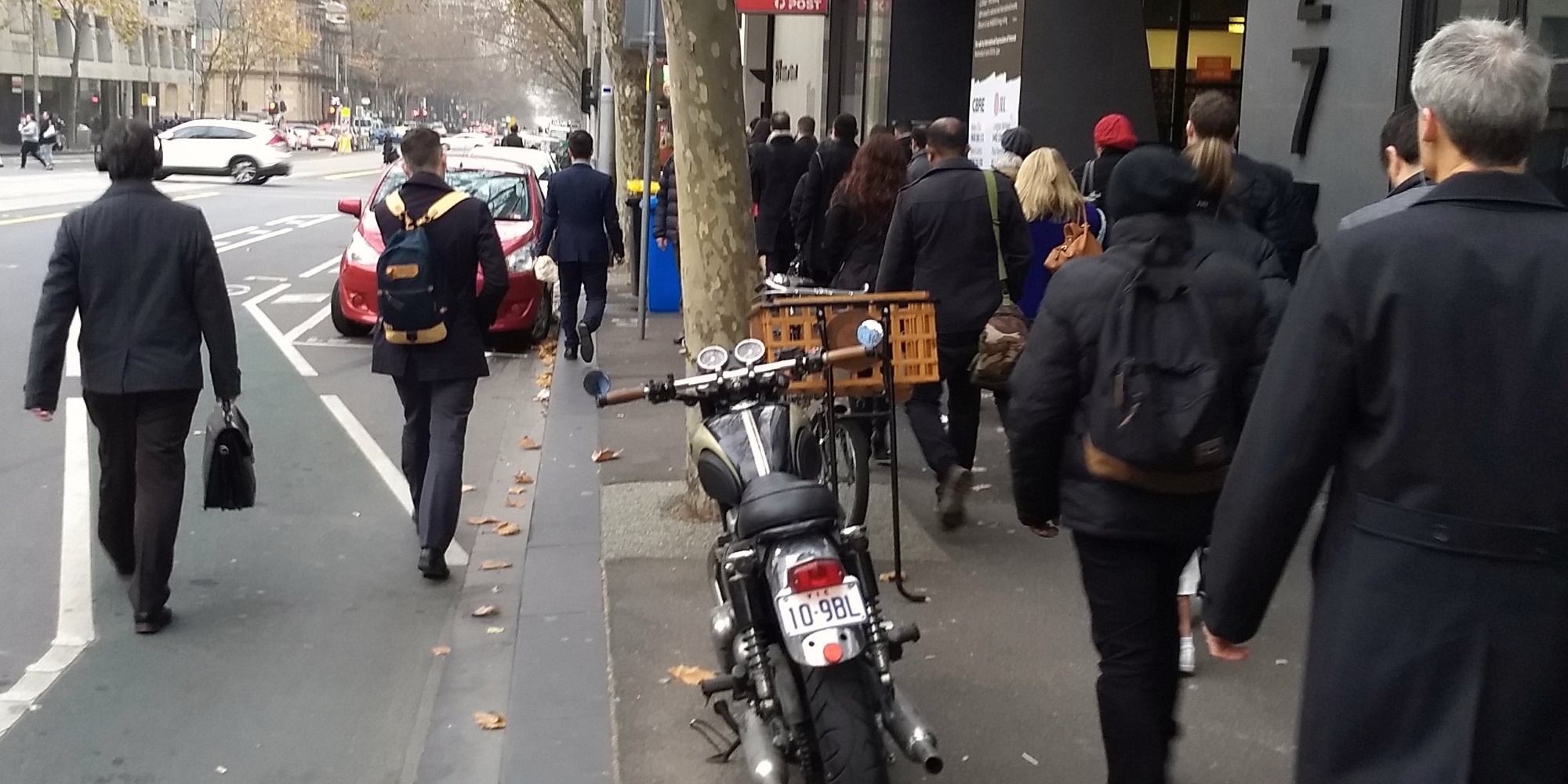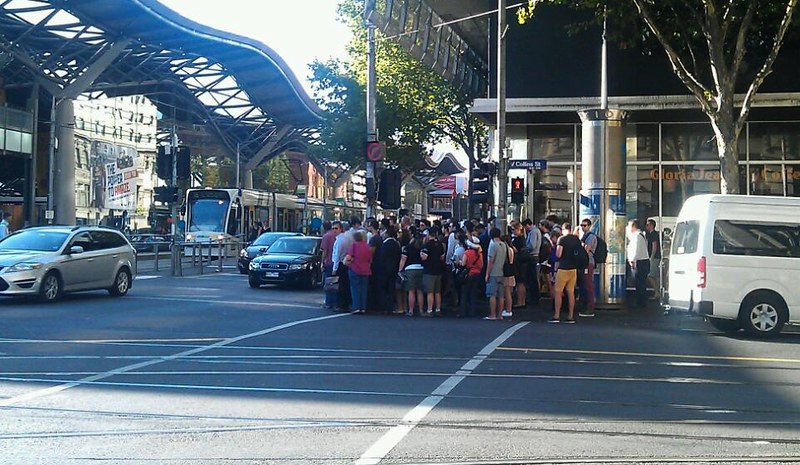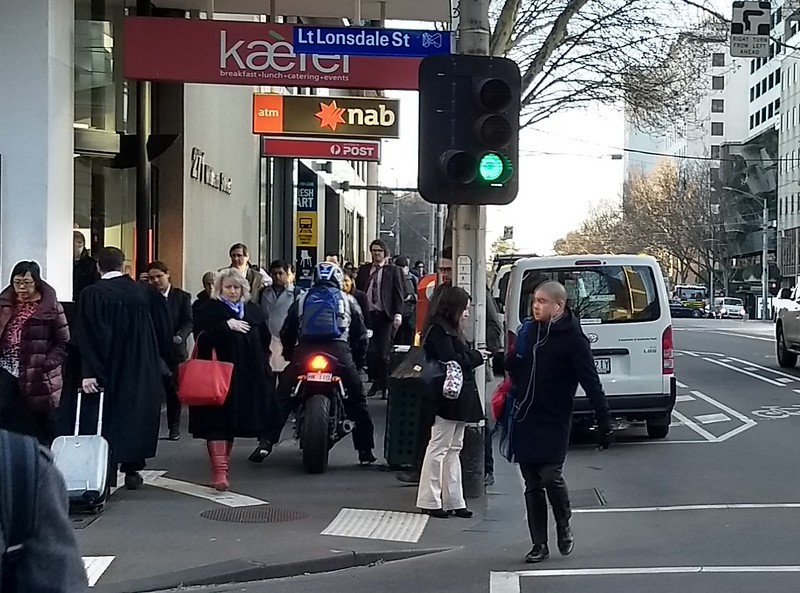For the proposals in City of Melbourne’s discussion papers to be described as “radical” and “ridiculous” just shows how far we haven’t come in transport planning in this state.
Perhaps it’s no surprise given that in the forthcoming election, if choosing a major party, we vote for either the mob who wants to build two massive motorways, or the mob who wants to build three massive motorways — the latter announced on a day of heavy smog, and despite Melbourne already having more motorways than most cities of its size.
Nowhere in the City of Melbourne discussion papers did they suggest outright banning cars in the CBD. And I think that would be a bridge too far; the Hoddle Grid is a far bigger area than any car-free central city areas around the world, and it would cause headaches for vehicles that have to be there, such as for deliveries.
But it’s blindingly obvious that in a central business district where the majority of people arrive and travel around without a car, that it’s time to stop allocating the majority of road space to a diminishing number of motorists.
Central cities are, by their nature, space constrained. Inner Melbourne is getting busier, with daily population expected to climb from almost a million now, to 1.5 million in the coming years.
So reducing space for motor vehicles, and discouraging motorists from coming into the CBD isn’t radical or ridiculous – it’s just commonsense.
Although the discussion paper is a long way from being City of Melbourne policy, it’s refreshing to see recognition of the issues.
Making CBD main streets a single lane each way for traffic. By my count, of the 14 streets in the Hoddle Grid, only 6 aren’t one lane each way, so this isn’t actually a big change. (Perhaps 6.5 if you count Flinders Street, a few sections of which have two lanes of traffic.)
Re-allocating a traffic lane and/or parking spaces to pedestrians and cyclists would be a big improvement. More separated cycling lanes and wider footpaths would be a win for the most efficient modes.
Queen Street and Lonsdale Streets should probably have 24/7 bus lanes implemented, given these are major bus corridors.
Optimising traffic lights is an obvious one. King Street’s dominance of light cycles in particular, is absurd, delaying east-west flow for pedestrians heading to/from Southern Cross Station, and trams. But it’s also a problem at other intersections, including William/Bourke. In fact the lights along Bourke Street are all over the place, playing havoc with the trams.
Motorcycle parking has long been a bugbear of mine. Given almost every person coming into the CBD is a pedestrian at some point during their visit (even those who drive), but journey to work mode share for motorcycles is just 0.7%, it’s ridiculous that these motor vehicles take up so much space on footpaths, with only unenforceable guidelines to stop them completely taking over.
Assuming we don’t align ourselves to every other state in Australia and ban footpath motorcycle parking outright, they should at least be restricted to designated areas where they won’t impact pedestrian flows and can be manoeuvred on and off the road without conflict.
In fact the whole question of street furniture needs looking at – footpaths are littered with obstacles, as shown in this short video:
Pedestrian Clearways
Walking is probably the most neglected transport mode. Even worse than buses.
It’s the most space-efficient, but increasingly squeezed for capacity as pedestrian numbers grow.
Let me put forward a modest, simple proposal: The busiest parts of the city centre should have Pedestrian Clearways.
Concentrate initially on the spaces around the railway stations, which see the largest pedestrian flows:
- No motorcycle parking
- No outdoor dining at peak times
- Advertising bikes prohibited
- Fixed rubbish bins, letter boxes, bike hoops, information and sales kiosks, parking signs and other street furniture either removed completely, or minimised — and designed to be as much out of the way as possible
- Garbage collection from buildings moved to adjoining laneways or side streets, or scheduled so that bins are clear of footpaths during peak hours
- Careful placement of trees to maximise available space
- Removal of parking to allow wider footpaths
- Traffic light programming to prioritise pedestrian flows
- Rigid enforcement of Rule 128, requiring motorists to keep clear of intersections and crossings
There’s a great opportunity to ease crowding on our CBD streets.
In a constrained space like the city centre, encouraging more people to walk and use public transport can only be a good thing.
But you can’t just wish for improvements. It’s high time authorities acted to prioritise pedestrians.



13 replies on “Here’s an idea: Pedestrian Clearways”
Some good points here Daniel, particularly around the problems with motorcycle parking and pedestrian flow.
The council should also examine the impact of construction works on the footpaths, particularly where a walkway is mostly blocked for months at a time (current examples include corner of King/Latrobe, Lonsdale between Elizabeth/Queen, and Exhibition between Collins/Little Collins). The combination of construction hoardings and temporary above-footpath infrastructure can easily create a pedestrian bottleneck – let alone the problems this might cause for wheelchairs or strollers.
One other thought – I don’t know if police have the resources to enforce the rule, but educating cyclists to stay off footpaths would go a long way to making things easier for pedestrians. We seem to have quite a few residents/visitors who don’t know (or don’t care) about this, and fail to use the cycle paths.
Here’s an idea: provide designated on-street parking for motorbikes and bicycles.
Converting car parks with hoops for bicycle parking is easy and cheap. Putting motorcycle symbols on parking spaces is also easy and cheap. I’m not sure why these haven’t been done, perhaps someone can explain it for me (maybe Daniel Andrews, since he seems to know a lot).
While it is good see more space for bike lanes or pedestrians one thing the proposal lack is plan for bus priority.
Other than the places that already got them there seem be no futher for more bus priorty, with most proposal giving space for bike lanes or pedestrians but not buses. e.g no plans what so ever for bus priorty on Spencer St, Dudley St, Raithdowne St, Southbank Blvd.
Rule 128? Ha! It does not exist.
Police often have their “jaywalking” blitzes to train new recruits along Flinders St.
In the middle of booking numerous pedestrians, cars every single cycle break 128 blocking the intersection, but they are all given a free pass.
Literally every night home from work there are 3 phases of cars all blocking each other plus trams and nothing is done about it. Including running reds to block traffic further.
How about no parking on major streets and extend the pedestrian zone (footpath).Less than 10 cars parked in the video at the expense of 100’s of pedestrians.
@George
Motorcyclists and Cyclists will complain about extending their trip if you provide centralised parking spots and ask them to walk the extra 50-100m. From the point of view of anyone not on those modes it seems a sensible way forward but be ready for well orchestrated backlash!
Advertising bicycles are becoming ever more prevalent around the city:
https://meltdblog.wordpress.com/2016/02/10/stealing-space/
Just to dodge the permit for a sandwich board (which would likely be rejected owing to the lack of space).
Meltdblog, parking near to where you’ve biked to is one of the advantages of being on a bicycle, for sure. It would be a step backwards to reduce the number of bike parking locations or make them inconvenient, given that this is a mode we’d like to encourage (for its substantial health, congestion, noise, and environmental benefits). I’m sure we can manage to take a few carparks without pushing cyclists to the margins.
I think its a great idea, make it clear that the footpath is for pedestrians. We have the odd situation that riding a bicycle is an offence on the footpath but all the bicycle parking is put there. Motor cyclists have a special exemption to allow them to ride on the footpath and take advantage of that to travel into pedestrian areas at the north end of Swanston St around the state library and RMIT university.
Placing the parking for those modes on the road is obvious, and can highlight just how inefficient cars really are when people see many more bikes in the same space. Again a tough challenge will be to convince the motorcyclists and cyclists that parking can fill up and they might not be sure of finding a space, just like other vehicles.
Funny, your pedestrian clearway idea sounds like modern urban planning policy which unfortunately in Melbourne is only implemented sporadically.
Sick of those food delivery wankers that block the footpath with their bloody scooters.
Is the motorbike parking issue something that can be fixed at the Melbourne City Council level, or do we have to deal with the state government?
@Paul, the laws generally permitting motorcycle parking are state laws.
But the council can ban it in specific areas, as they have already done in parts of Collins St, Exhibition St, and Flinders Lane.
The problem is those three small areas were chosen nearly 20 years ago, when the CBD was far less busy, and haven’t been expanded since.
I’m glad this is on the agenda. I’m so sick of negotiating my way through a sea of motorcycles, chained bicycles and food delivery scooters around the Flinders Street / Elizabeth Street area. I’ve seen young kids injure themselves walking into these bikes, and I’ve taken my own share of whacks from tyres, pedals and handlebars that stick out. One of these days I’m going to seriously lose it and just start kicking back. Argh.
What a shame one of the cities most important pedestrian thoroughfares is so dangerous, ugly and cluttered with all this crap!! :-(